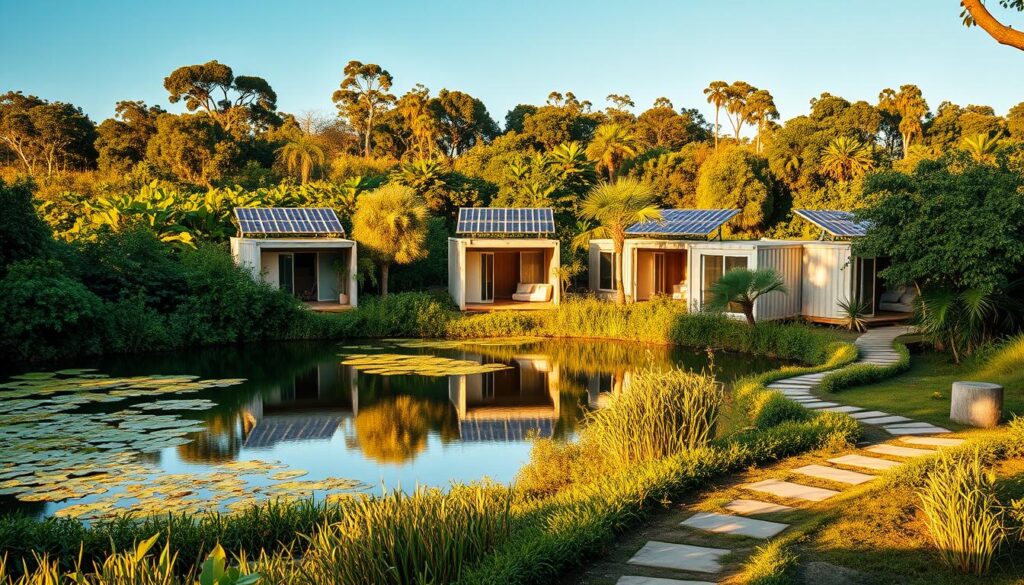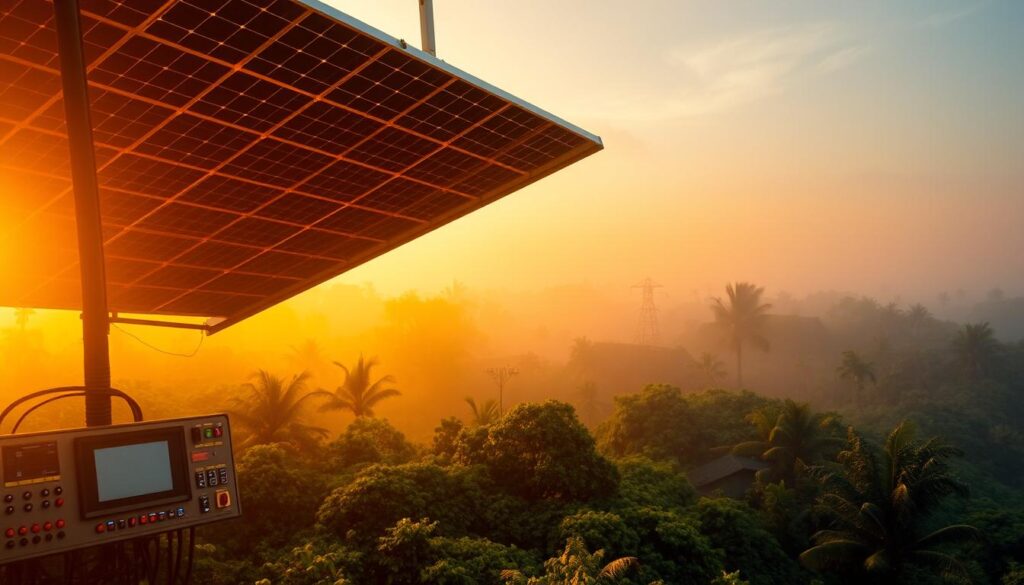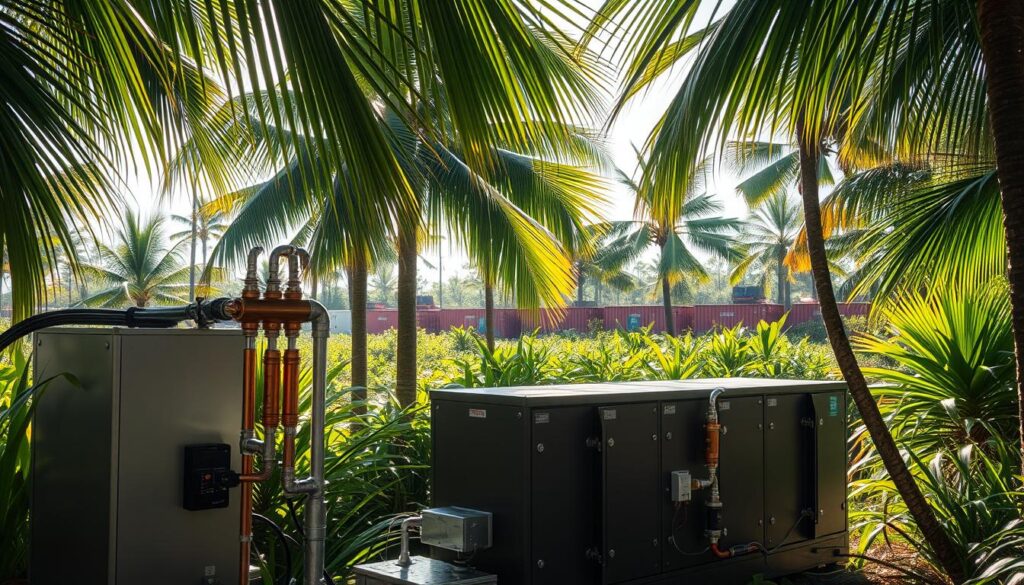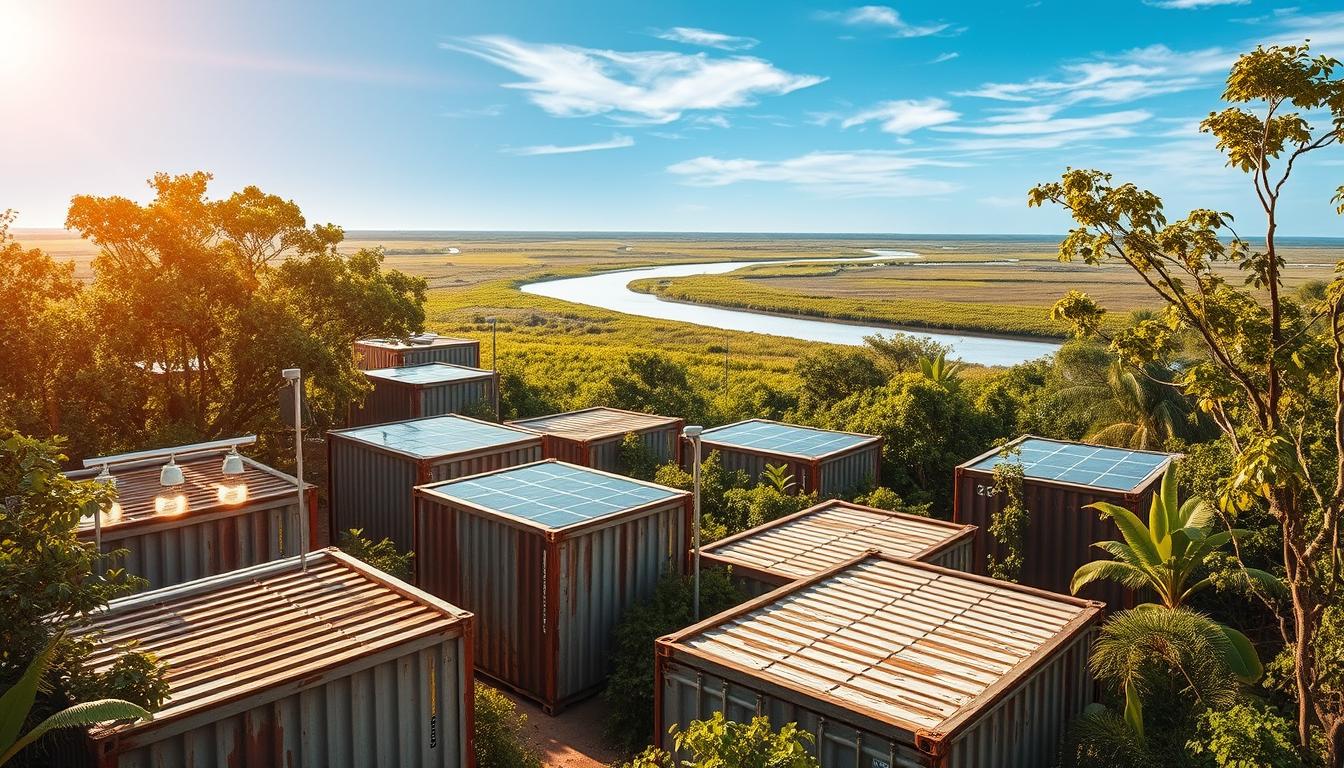The concept of shipping container homes is gaining popularity worldwide, and the Pantanal wetlands in Brazil are no exception. This unique region, known for its rich biodiversity, presents both opportunities and challenges for sustainable living.
Implementing solar energy management in these homes can significantly reduce their carbon footprint. The high humidity in Pantanal requires specialized solar control systems that can efficiently manage energy production.
Key Takeaways
- Efficient solar energy management is crucial for shipping container homes.
- The Pantanal wetlands environment poses unique challenges for energy production.
- Specialized solar control systems are necessary for high-humidity environments.
- Sustainable living in shipping container homes can reduce carbon footprint.
- Renewable energy solutions are becoming increasingly popular in unique ecosystems.
The Unique Challenges of Pantanal’s Wetland Environment
Solar energy management in the Pantanal wetlands requires a deep understanding of the region’s climatic and geographical characteristics. The Pantanal, being the world’s largest tropical wetland area, located in Brazil, presents a unique set of challenges for renewable energy installations.
Geographical and Climate Characteristics of Pantanal
The Pantanal region is known for its diverse wildlife and complex ecosystem. Its geographical characteristics include vast floodplains and a network of rivers, which significantly influence the local climate.
Seasonal Flooding Patterns and Humidity Levels
One of the main challenges in Pantanal is the seasonal flooding, which can last for several months. This flooding, combined with high humidity levels throughout the year, poses significant challenges for the installation and maintenance of solar energy systems. High-humidity solar systems must be designed to withstand these conditions.
Temperature Fluctuations Throughout the Year
The temperature in Pantanal varies significantly throughout the year, with hot summers and mild winters. These temperature fluctuations can affect the efficiency of solar panels, making it crucial to select panels that can perform well under varying temperature conditions.
Understanding these environmental factors is crucial for the successful implementation of solar energy projects in the Pantanal wetlands. By considering the geographical and climatic characteristics, developers can design more effective and resilient solar energy systems.
Shipping Container Homes: A Sustainable Housing Solution

In the wetlands of Pantanal, Brazil, shipping container homes offer a unique blend of sustainability and resilience. These homes are not only eco-friendly but also provide a practical solution to housing challenges in wetland areas.
Advantages of Container Homes in Wetland Areas
Shipping container homes have several advantages when it comes to wetland environments. They are mobile and adaptable, making them ideal for areas that are prone to flooding.
Mobility and Adaptability During Flood Seasons
During flood seasons, the mobility of shipping container homes allows residents to relocate temporarily, ensuring their safety. This adaptability is crucial in wetland areas where flooding is a regular occurrence.
Durability Against Extreme Weather Conditions
Shipping containers are designed to withstand harsh weather conditions, including high winds and heavy rains. Their durability makes them an excellent choice for sustainable housing in challenging environments.
| Advantages | Benefits |
|---|---|
| Mobility | Temporary relocation during floods |
| Durability | Withstands extreme weather conditions |
| Sustainability | Eco-friendly housing solution |
The use of shipping container homes in wetland areas like Pantanal not only provides a sustainable housing solution but also promotes the use of renewable energy sources, such as solar power, to meet energy needs.
Energy Needs and Consumption Patterns in Remote Wetland Areas
Remote wetland areas have specific energy consumption patterns that are crucial to understand for effective energy management. Living in shipping container homes within these environments requires a careful analysis of energy needs to ensure sustainable and efficient energy use.
Typical Energy Requirements for Container Home Living
Container homes in remote wetland areas have unique energy requirements due to their isolated location and the challenging environmental conditions. The energy needs can be broadly categorized into essential appliances, lighting, and communication systems.
Essential Appliances and Systems
Residents of container homes in wetland areas rely on various appliances for daily living. These include:
- Refrigeration units for food storage
- Lighting systems for illumination
- Water purification systems
- Climate control systems for maintaining a comfortable temperature
Communication and Connectivity Needs
In addition to basic appliances, communication and connectivity are vital for residents in remote areas. This includes:
- Internet connectivity for staying in touch with the outside world
- Telecommunication devices for emergency services
- Satellite TV or streaming services for entertainment
Understanding these energy needs is crucial for designing effective smart energy management systems. By optimizing energy consumption, residents can reduce their reliance on non-renewable energy sources and lower their overall energy costs.
| Appliance/System | Average Energy Consumption (kWh) | Frequency of Use |
|---|---|---|
| Refrigeration Unit | 1.2 | Daily |
| Lighting System | 0.5 | Daily |
| Water Purification System | 0.8 | Daily |
| Climate Control System | 2.0 | Daily |
Solar Control Systems for High-Humidity Environments: Core Technologies

High-humidity environments pose significant challenges to solar energy systems, necessitating advanced solar control technologies. In regions like Pantanal, Brazil, where the climate is characterized by high temperatures and humidity, solar control systems play a vital role in ensuring the efficiency and reliability of solar energy.
Humidity-Resistant Solar Panel Designs
To address the challenges posed by high humidity, solar panel designs have evolved to incorporate humidity-resistant features. One of the key advancements is the use of marine-grade photovoltaic technologies, which are designed to withstand the corrosive effects of saltwater and high humidity.
Marine-Grade Photovoltaic Technologies
Marine-grade photovoltaic technologies involve the use of materials and coatings that are resistant to corrosion and can withstand the harsh marine environment. These technologies are particularly relevant for solar installations in coastal and wetland areas.
Encapsulation Methods for Moisture Protection
Another critical aspect of humidity-resistant solar panel design is the encapsulation method used to protect the photovoltaic cells from moisture. Advanced encapsulation techniques, such as ethylene-vinyl acetate (EVA) encapsulation, provide a durable barrier against moisture ingress, ensuring the long-term reliability of the solar panels.
The following table summarizes the key features of humidity-resistant solar panel designs:
| Feature | Description | Benefit |
|---|---|---|
| Marine-Grade Photovoltaic Technologies | Corrosion-resistant materials and coatings | Enhanced durability in harsh environments |
| Encapsulation Methods | Advanced materials like EVA for moisture protection | Improved reliability and lifespan |
By incorporating these advanced technologies, solar control systems can effectively manage the challenges posed by high-humidity environments, ensuring reliable and efficient solar energy production.
Smart Energy Management Solutions for Wetland Conditions
The unique conditions of wetland environments necessitate advanced smart energy management solutions for sustainable living. In regions like Pantanal, Brazil, where shipping container homes are becoming increasingly popular, the need for efficient and reliable energy management is paramount.
IoT-Based Monitoring Systems
One of the key technologies driving smart energy management in wetland areas is IoT-based monitoring systems. These systems enable real-time tracking and control of energy production and consumption, allowing homeowners to optimize their energy use.
Real-Time Performance Tracking
Real-time performance tracking is a critical feature of IoT-based monitoring systems. It allows homeowners to monitor their energy production and consumption patterns closely, making adjustments as needed to maximize efficiency. As noted by industry experts, “Real-time data is crucial for making informed decisions about energy management.”
“The integration of IoT technologies in energy management has revolutionized the way we approach renewable energy in remote and challenging environments.”
Weather-Responsive Automation
Another significant advantage of IoT-based monitoring systems is their ability to automate responses to weather changes. In wetland areas, where weather conditions can be highly variable, this feature ensures that energy production is optimized and equipment is protected from extreme weather events.
By leveraging IoT-based monitoring and renewable energy sources, shipping container homes in wetland regions can achieve a high level of energy independence and sustainability. As the demand for eco-friendly housing solutions continues to grow, the importance of smart energy management will only continue to increase.
Battery Storage Innovations for High-Humidity Settings

Advancements in sealed battery technologies are revolutionizing solar energy storage in high-humidity environments such as Pantanal. The unique challenges posed by humid climates necessitate innovative solutions to ensure the reliability and efficiency of solar energy systems.
Sealed Battery Technologies
Sealed battery technologies have emerged as a critical component in addressing the challenges of high-humidity settings. These batteries are designed to be maintenance-free and resistant to the corrosive effects of humidity.
Lithium-Ion Solutions with Humidity Protection
Lithium-ion batteries with specialized humidity protection are becoming increasingly popular for solar energy storage in humid climates. These batteries incorporate advanced materials and designs that prevent moisture ingress, thereby enhancing their lifespan and performance.
Gel and AGM Battery Applications
Gel and Absorbent Glass Mat (AGM) batteries are other examples of sealed battery technologies that are well-suited for high-humidity environments. These batteries are known for their durability and resistance to vibration, making them ideal for remote solar installations.
The following table highlights the key features of these battery technologies:
| Battery Type | Humidity Resistance | Maintenance Requirements | Lifespan |
|---|---|---|---|
| Lithium-Ion with Humidity Protection | High | Low | Up to 10 years |
| Gel Batteries | High | Low | Up to 8 years |
| AGM Batteries | High | Low | Up to 7 years |
In conclusion, sealed battery technologies, including lithium-ion solutions with humidity protection and gel/AGM batteries, are crucial for enhancing the reliability of solar energy systems in high-humidity settings. By understanding the benefits and applications of these technologies, individuals can make informed decisions about their solar energy storage needs.
Installation Best Practices for Pantanal Container Homes
The unique environment of Pantanal demands specialized installation practices for solar energy systems in container homes. Installers must consider the region’s high humidity, frequent flooding, and extreme weather conditions when designing and implementing solar panel installations.
Elevated Mounting Techniques
Elevated mounting techniques are crucial in Pantanal to protect solar panels from floodwaters and to ensure adequate airflow for cooling. Elevating the panels also helps in reducing the accumulation of debris and sediment that can compromise the system’s efficiency.
Roof integration involves installing solar panels directly onto the roof of the container home. This method provides a secure and stable platform for the panels. Proper sealing and waterproofing are essential to prevent water ingress and maintain the structural integrity of the container home.
Adjustable Racking Systems
Adjustable racking systems offer flexibility in optimizing the angle and orientation of solar panels according to the sun’s position. This is particularly beneficial in Pantanal’s varying weather conditions, allowing for maximized energy production throughout the year.
| Installation Method | Benefits | Challenges |
|---|---|---|
| Elevated Mounting | Protection from floods, improved airflow | Increased installation complexity |
| Roof Integration | Secure installation, aesthetic integration | Waterproofing challenges |
| Adjustable Racking | Optimized energy production, flexibility | Higher initial cost |
By adopting these installation best practices, homeowners and installers can ensure that solar energy systems in Pantanal’s container homes are efficient, durable, and capable of withstanding the region’s challenging environmental conditions.
Maintenance Protocols for Solar Systems in Extreme Humidity
Maintaining solar systems in extreme humidity is crucial for their longevity and efficiency. The humid environment of Pantanal, Brazil, poses unique challenges to solar energy systems, particularly in shipping container homes.
Preventative Maintenance Schedules
Implementing a preventative maintenance schedule is vital to mitigate the effects of high humidity. This includes regular inspections and timely replacements of components.
Monthly and Seasonal Inspection Routines
Monthly inspections should focus on checking for corrosion on electrical components and ensuring that all connections are secure. Seasonally, a more thorough inspection is required, including checking the integrity of the solar panel coatings and the condition of the mounting structures.
Component Replacement Timelines
Understanding when to replace components is critical. For instance, seals and gaskets may need to be replaced every few years to prevent moisture ingress.
| Component | Inspection Frequency | Replacement Timeline |
|---|---|---|
| Solar Panels | Monthly | Every 10 years |
| Electrical Connections | Quarterly | Every 5 years |
| Seals and Gaskets | Seasonally | Every 3 years |
By adhering to these maintenance protocols, homeowners can ensure their solar systems remain efficient and durable, even in the challenging environment of Pantanal.
Case Studies: Successful Solar Implementations in Pantanal
The adoption of solar energy in the Pantanal region has been gaining momentum, particularly in innovative housing solutions. In the heart of Brazil’s wetlands, the Porto Jofre Container Community stands out as a beacon for successful solar energy implementation.
Porto Jofre Container Community
The Porto Jofre Container Community is a pioneering project that has effectively harnessed solar energy to power its shipping container homes. This community serves as a model for sustainable living in challenging wetland environments.
System Design and Performance Metrics
The solar energy system in Porto Jofre was designed with the local climate in mind, incorporating humidity-resistant solar panels and an IoT-based monitoring system to optimize energy production. Performance metrics indicate a significant reduction in energy costs and carbon footprint.
Challenges Overcome and Lessons Learned
Despite the challenges posed by the high-humidity environment, the Porto Jofre community has successfully overcome issues related to energy storage and supply. Key lessons learned include the importance of regular maintenance and the use of sealed battery technologies to ensure system reliability.
The success of the Porto Jofre Container Community demonstrates the viability of solar energy in remote wetland areas. By adopting innovative technologies and tailored system designs, similar communities can replicate this success, contributing to a more sustainable future.
Economic Analysis: Cost vs. Benefits in Remote Wetland Applications
A comprehensive economic analysis is necessary to understand the feasibility of solar energy systems for shipping container homes in remote wetland applications. This analysis involves evaluating both the initial investment and the long-term benefits.
Initial Investment Considerations
The initial investment for solar energy systems in remote wetland areas includes several key components. Understanding these costs is crucial for a thorough economic analysis.
Equipment and Transportation Costs
The cost of solar panels and other necessary equipment is a significant upfront expense. Additionally, transporting this equipment to remote areas like Pantanal can be costly due to logistical challenges.
- Equipment Costs: Solar panels, batteries, and mounting hardware.
- Transportation Costs: Logistics, transportation vehicles, and potential storage fees.
Installation and Setup Expenses
Installation costs include labor, preparation of the site, and ensuring that the system is compatible with the container home’s energy needs.
- Labor Costs: Skilled labor for installation and setup.
- Site Preparation: Preparing the site for solar panel installation.
By understanding these initial investment considerations, decision-makers can better assess the economic viability of solar energy systems for their shipping container homes in remote wetland areas.
Conclusion: The Future of Solar-Powered Living in Wetland Ecosystems
The Pantanal region in Brazil presents a unique set of challenges for sustainable living, but solar-powered container homes offer a promising solution. By leveraging smart energy management systems, humidity-resistant solar panels, and innovative battery storage, residents can enjoy a reliable and renewable energy supply.
Solar-powered living in wetland ecosystems like Pantanal not only reduces reliance on fossil fuels but also minimizes environmental impact. As the world shifts towards the future of renewable energy, such initiatives serve as a model for sustainable development in challenging environments.
With continued advancements in solar technology and energy storage, the potential for solar-powered living in wetland ecosystems is vast. By adopting these solutions, communities can thrive while preserving the natural beauty and biodiversity of sensitive ecosystems like Pantanal.
FAQ
What are the benefits of using shipping container homes in wetland areas like Pantanal, Brazil?
Shipping container homes offer several benefits in wetland areas, including mobility and adaptability during flood seasons, as well as durability against extreme weather conditions, making them a sustainable housing solution.
How do smart solar energy management systems optimize energy use in remote wetland areas?
Smart solar energy management systems optimize energy use by monitoring energy consumption patterns, predicting energy demand, and adjusting energy supply accordingly, ensuring efficient use of solar energy in remote wetland areas.
What are the core technologies behind solar control systems designed for high-humidity environments?
The core technologies include humidity-resistant solar panel designs, such as marine-grade photovoltaic technologies and encapsulation methods that protect against moisture, ensuring the reliability and efficiency of solar energy systems.
How do IoT-based monitoring systems enhance the efficiency of solar energy systems in wetland conditions?
IoT-based monitoring systems enable real-time performance tracking and weather-responsive automation, allowing for adjustments to be made to optimize energy production and consumption, thus enhancing the efficiency of solar energy systems.
What are the best practices for installing solar energy systems in shipping container homes in Pantanal?
Best practices include elevated mounting techniques, roof integration methods, and adjustable racking systems, which help ensure the stability and efficiency of solar energy systems in challenging wetland environments.
What maintenance protocols are recommended for solar systems operating in extreme humidity?
Recommended maintenance protocols include preventative maintenance schedules, such as monthly and seasonal inspection routines, and component replacement timelines, to ensure the longevity and efficiency of solar energy systems.
What are the initial investment considerations for implementing solar energy systems in remote wetland applications?
Initial investment considerations include equipment and transportation costs, as well as installation and setup expenses, which should be carefully evaluated against the long-term savings and benefits of solar energy systems.
How do sealed battery technologies improve the reliability of solar energy systems in high-humidity settings?
Sealed battery technologies, such as lithium-ion solutions with humidity protection and gel/AGM battery applications, improve the reliability of solar energy systems by protecting against moisture and ensuring consistent performance.
